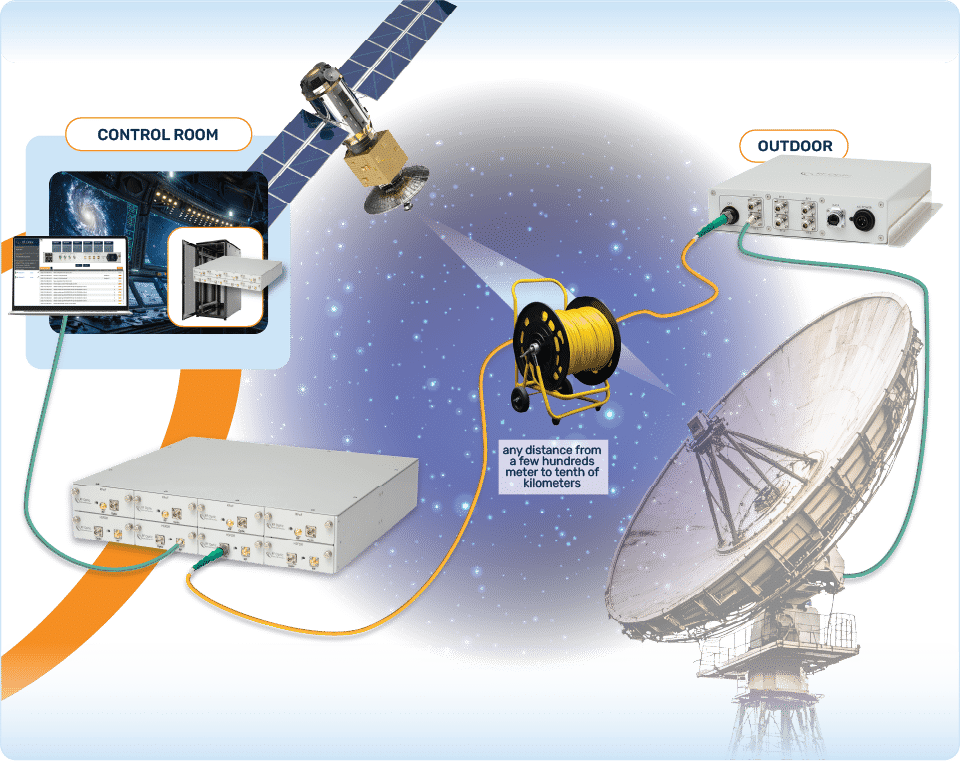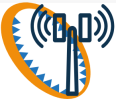
SATCOM Application
This application note details the benefits of using RF over Fiber (RFoF) technology for satellite communication (Satcom) systems, focusing on the advantages of a dual-link redundant architecture for improved reliability and system uptime. RFoF solutions offer significant improvements over traditional coaxial cable systems in terms of distance, bandwidth, and signal quality, making them ideal for demanding Satcom applications.
Why use RF over Fiber and not coax for Satcom?
Traditional coaxial cable systems in Satcom applications suffer from several limitations:
- Signal Attenuation: Coaxial cables experience significant signal loss over long distances, requiring amplification and potentially compromising signal quality.
- Bandwidth Limitations: Coaxial cables have limited bandwidth, restricting the amount of data that can be transmitted.
- Susceptibility to Interference: Coaxial cables are susceptible to electromagnetic interference (EMI), which can degrade signal quality and introduce errors.
- Cost and Installation: Coaxial cable installation can be expensive and time-consuming, especially for long-distance deployments.
RFoF overcomes these limitations by transmitting RF signals over optical fiber, enabling high bandwidth, low loss transmission over long distances with superior immunity to EMI.
Key characteristics
RFoF systems for Satcom applications typically comprise:
- RF to Optical Converter: Converts the RF signal from the satellite receiver or transmitter to an optical signal.
- Optical Fiber: Transmits the optical signal over long distances with minimal loss.
- Optical to RF Converter: Converts the optical signal back to an RF signal at the receiving end.
- Redundant Link: A second, independent RFoF path is implemented to provide fail-safe operation in case of a primary link failure. This dual-link redundancy ensures continuous operation and minimizes downtime.
Main Applications
Applications of Remote Antennas with Fiber Optic Transport include:
- Defense & Tactical Systems – Remote antennas for secure, interference-free communication.
- Aerospace & Aviation – Ground station antennas requiring long-distance connectivity.
- Telecommunications – Distributed antenna systems (DAS) and cellular network extensions.
- Broadcasting & Media – Remote antennas for clear, high-frequency signal transmission.
- Scientific & Research Facilities – Radio astronomy and environmental monitoring applications.
By replacing traditional coaxial cable with fiber optic links, remote antennas can be positioned anywhere, ensuring high-quality signal transmission, reduced maintenance, and improved system performance.
System Configuration Example
The frequency range supported by the RFoF system depends on the specific components used. Modern RFoF systems can support a wide range of frequencies, accommodating various satellite communication bands (e.g., L, S, C, Ku, Ka). The optical fiber’s bandwidth capacity far exceeds the requirements of even the highest bandwidth satellite communication systems. Coverage area is limited only by the physical reach of the fiber optic infrastructure and the satellite’s footprint.
A dual-redundant RFoF Satcom system consists of two parallel RFoF links between the antenna and the data processing center. Each link incorporates an RF-to-optical converter at the antenna, an optical fiber cable, and an optical-to-RF converter at the processing center. A monitoring system continuously checks the integrity of both links, switching to the backup link upon detection of a failure in the primary link. This ensures continuous operation and minimizes service disruptions.
Deployment
- Outdoor Units: RF to optical converters, weatherproof enclosures.
- Indoor Units: Optical to RF converters, redundancy switching units, monitoring equipment.
Installation is typically performed by trained personnel, and RFOptic can provide the necessary cables upon request.
Monitoring & Control
The RFoF system incorporates comprehensive monitoring and control capabilities. These include real-time status monitoring of optical signal power levels, link quality, and system health. Remote monitoring and control features facilitate proactive maintenance and troubleshooting, minimizing downtime.
Conclusion
RFoF technology with dual-link redundancy provides a reliable, high-bandwidth, and cost-effective solution for modern Satcom applications. Its superior performance compared to traditional coaxial systems results in improved signal quality, reduced interference, and increased system uptime, making it an ideal choice for critical communication needs.
Contact Us







